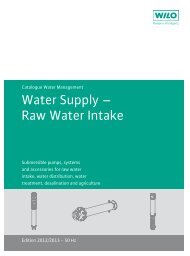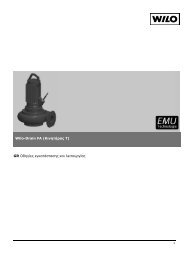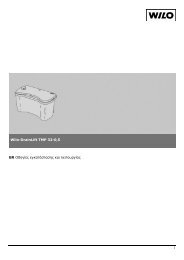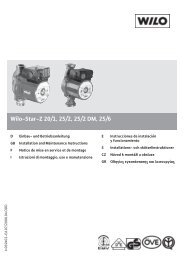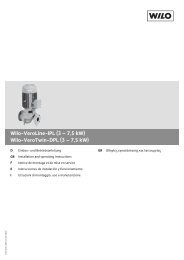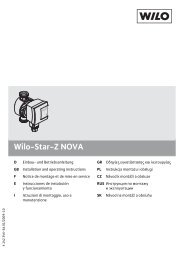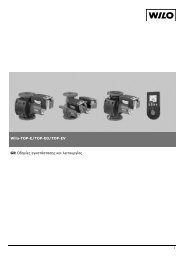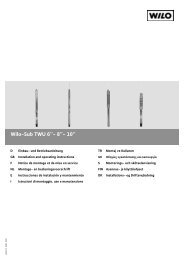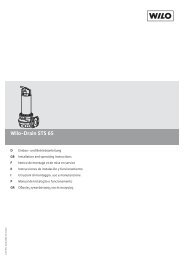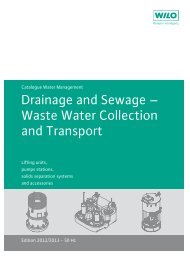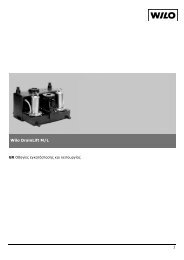'UDLQDJH DQG 6HZDJH À :DVWH :DWHU 7UDQVSRUW ... - WILO
'UDLQDJH DQG 6HZDJH À :DVWH :DWHU 7UDQVSRUW ... - WILO
'UDLQDJH DQG 6HZDJH À :DVWH :DWHU 7UDQVSRUW ... - WILO
Create successful ePaper yourself
Turn your PDF publications into a flip-book with our unique Google optimized e-Paper software.
Planning guideMotorsMonitoring equipmentThe integrated monitoring units are for protecting the motor:• Excess temperature in winding/bearing/oil• Over pressure in the motor• Penetration of water in- sealing chamber- leakage chamber- motor compartment- clamping spaceThe possible sensor equipment depends on the different motortypes. The individual sensors will be described below.Bimetal temperature sensorBimetal temperature sensors are mechanical switches which trigger aswitching operation as a result of heat. "Normally closed contacts"are used, i.e. when the tripping temperature is reached, the electricalcircuit is interrupted. When the temperature drops accordingly (hysteresis),the sensor closes automatically again. 2 or 3 temperaturesensors are installed in series in the windings. Another applicationoption is the monitoring of the oil temperature in oil motors. In Exmotors for submerged operation and in special versions, there are 2temperature circuits with different tripping temperatures.Application for the following:• Slowly rising temperatures, e.g. obstruction of cooling by deposits• Overload• Surfacing of motors that may only operate in submerged state• Unacceptably high ambient temperatures• Operating time too long during S2 operationThermistor/PTCPTC thermistor sensors are temperature-sensitive resistors. Thesesensors do not have any mechanical components. When the nominalactivation temperature (NAT) is reached, the electrical resistance ofthe sensors increases rapidly. This change is evaluated by an electronicswitchgear. 3 temperature sensors are installed in series in thewindings. In large machines and special versions, there are 2 temperaturecircuits each with different tripping temperatures(e.g. 130/140 °C). A switchgear is required for each temperaturecircuit (e.g. <strong>WILO</strong> CM-MSS).Application for the following:• All types of temperature protection• Blocking of sewage motors• Motors for speed control (specification for Ex motors on the converter)PT 100 temperature sensorPT 100 sensors are temperature-dependent resistors with an almostlinear pump curve. At 0 °C, the resistance is 100 . The resistance differencebetween 0 and 100 °C is 0.385 /K. This change is evaluatedby an electronic switchgear (e.g. <strong>WILO</strong> DGW 2.01 G). The switchingtemperature is determined by the setting on the switchgear, not bythe sensor. In addition to the adjustment of the switching points, thetemperature can also be measured.In order to be able to compensate the fault caused by the line resistance,the connection is usually established in the form of three-wireswitching. Almost all PT 100 evaluation relays support this connection.Leakage floaterLeakage floaters are mechanical switches that trigger a switching operationin the event of fluid penetration. Therefore if fluid penetratesthe leakage chamber via the second mechanical seal, the motor canbe shut down or a warning emitted. "Normally closed contacts" areused, i.e. if fluid enters the leakage chamber, the electrical circuit isinterrupted.No special relay is required for the evaluation. The switching capacityof the floater contacts deviates with different motor types and musttherefore be taken from the connection diagram for the respectivemotor.Pressure switchPressure switches are mechanical switches that trigger a switchingoperation in the event of over pressure in the motor. They are used inmotors that have an oil-filled motor compartment. "Normally closedcontacts" are used, i.e. when an over pressure builds up in the motor,the electrical circuit is interrupted.No special relay is required for the evaluation.Thermal float switchThermal float switches are mechanical switches that trigger a switchingoperation in the event of a low oil level or if the temperature inthe motor is too high. They are used in motors that have an oil-filledmotor compartment. "Normally closed contacts" are used, i.e. if thereis a lack of oil or if the temperature of the oil is too high, the electricalcircuit is interrupted.No special relay is required for the evaluation.Conductive electrodesConductive electrodes (based on the measurement of the resistance)are used to evaluate conductive fluids. The sensor consists mainly ofa rust-proof electrode rod. It is used to measure the conductivity ofthe fluid in relation to a reference earth (motor housing). This changeis evaluated by an electronic switchgear (e.g. Wilo NIV 101). Theswitching resistance is determined by the setting on the switchgear,not by the sensor.A special electrode relay is always required, e.g. Wilo NIV 101/A,NIV 105/S or ER 143 (for potentially explosive areas). The sensitivityof the relay is to be set to > 20 k.Application for the following:• Slowly rising temperature• e.g. cooling obstructed by deposits• Overload• Surfacing of motors that may only operate in submerged state• Unacceptable ambient temperature• Long running time during S2 operation• Blocking only to a limited extent22 Wilo Water Management catalogue – 50 Hz – Drainage and sewage – Waste water transport and dewatering – Edition 2012 – Subject to change without prior notice




